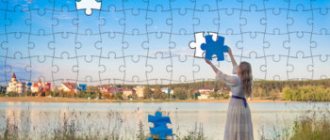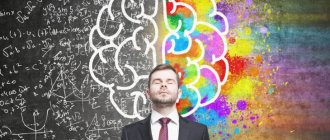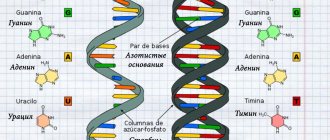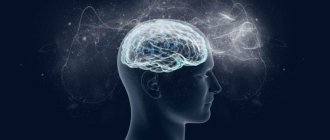When it comes to imagination, what comes to mind are the vivid fantasies of writers, artists, brilliant inventions of designers and discoveries of scientists. In fact, there are many more areas of use of imagination, some of which we are not even aware of. This mental process of creating images is actively involved in all types of human activity, not only conscious, but also unconscious. Imagination is so diverse that in psychology there is even a classification of its types.
Essence and mechanism of action
Imagination is closely related to memory, attention, and thinking. Formed as a result of the emergence of social consciousness, to which a person turns in a problematic situation. Ability refers to cognitive processes that reflect objective reality. The basis of reflection is images of perception, memory, and representation.
If thinking explores the world in a general way, imagination allows you to create specific forms. The performance creates full-fledged pictures, based on reality or generated by fantasy. An individual invents without having any initial data, imagines phenomena that he has never seen. Intelligence is associated with imagination. The higher the level of intelligence, the more active the work of mental processes.
The essence of imagination is to create new images based on existing ones. The intensity and completeness of the result depends on experience and knowledge. Imagination arises in the process of work when the need to predict actions arises. By imagining images, an individual goes beyond reality, anticipates the result of work, and revives memories.
Types of imagination
This process, as a complex mental process, also comes in several types. Regarding the features of the process, they distinguish: involuntary, voluntary, recreating, creative, and daydreaming.
Involuntary imagination is also called passive imagination. This is the simplest type and it consists in creating and combining ideas, their components into a new image, when a person does not have a direct intention to do this, when consciousness is weak, and control over the flow of ideas is small.
Passive imagination occurs in young children. It manifests itself most often when a person is in a drowsy, half-asleep state, then images appear on their own (therefore arbitrary), some change to others, they combine, take on the most unreal forms and types.
Such imagination operates not only in a sleepy state, it also manifests itself in a waking state. New ideas do not always appear when a person purposefully directs his consciousness to creation. A feature of the created images is their variability as a result of the instability of trace excitations of the brain and the ease of their interconnection with excitation processes in adjacent brain centers. Because the trajectory of arousal is not fixed, this makes imagination so easy. It is especially easy in children, who also lack critical thinking, which acts as a filtering mechanism in adults, so the child sometimes produces the most unrealistic, fantasized images. Only by acquiring life experience and forming a critical attitude, such unintentional imagination is gradually put in order and guides the consciousness, therefore a deliberate active idea is formed.
Voluntary imagination, also called active, is the deliberate construction of ideas according to the task at hand in a certain activity. Active imagination develops when children begin to play roles (doctor, salesperson, teacher). When they try to portray their role, they have to use their brains as accurately as possible, thus using their imagination. Further development of this process occurs when a person begins to act independently, shows initiative and creative efforts in the process of work, requiring clear and accurate representations of the subject that will be created from operations and which must be performed.
Active imagination is most manifested in human creative activity. In this process, a person sets himself a task, which is the starting point for the development of the imagination process. Since the product of this activity is objects of art, the imagination is governed by the requirements that follow from the specific characteristics of art.
The re-creating aspect of this process is that a person must create an image of an object that he has never seen, based on certain descriptions.
Recreating imagination, according to its psychological structure, is the translation of a second-signal stimulus into a re-signal image.
Recreative imagination embraces the creation of something that already exists and how it exists. It is not separate from reality, and if you move away from it a little, then the imagination will not correspond to the goals of cognition - to expand the field of human knowledge, reducing descriptions to visual images.
Recreating imagination helps a person to be transported to other countries, into space, to see historical events and objects that he has never seen before in his life, but can imagine after recreating. This process allows people who read works of fiction to recreate pictures, events and characters in their heads.
Creative imagination is also considered an active imagination; it is involved in the formation of new images in creative activities, art, science, and technical activities. Composers, writers, and artists use this process to depict life in images in their art. They create artistic images through which they reflect life as truthfully as possible, rather than photographically copying life events. These images also reflect the individuality of the creative person, his approach to life, and artistic style.
Creative imagination is also used in scientific activity, which cannot be interpreted as ordinary mechanical knowledge of phenomena. Building hypotheses is a creative process, which is then confirmed by practice.
There is another unique type of this process - this is a dream, as a representation of what is desired in the future. It is created in a meaningful way, as opposed to unintentional daydreaming. A person consciously directs his thoughts to the formation of desired goals, planning strategies to achieve these goals and translating them into real life.
Daydreaming can be useful, but it can also be harmful. When a dream is transcendental, unrealistic, and unrelated to life, it weakens a person’s will, reduces his activity and slows down psychological development. Such dreams are empty, meaningless, they are called dreams. When a dream is connected with reality, and potentially real, it helps a person to mobilize, unite efforts and resources to achieve a goal. Such a dream is an incentive for active action and the rapid development of the best qualities of an individual.
History of discovery and study
In Russian psychology, interest in the phenomenon arose along with the study of other functions of the psyche. The main contribution to the study process was made by L. Vygotsky. He dedicated a book and dozens of articles to the imagination - a fundamental presentation of findings and theories regarding the development of the ability to imagine in ontogenesis.
Vygotsky paid great attention to the development of cognitive processes in preschool age. The scientist believed that this period was critical. He considered the ability to imagine in preschool age as the ability to create a whole from elements.
Vygotsky noted the complexity of mental activity and gradual development. According to his theory, creative activity depends on acquired experience. The child expresses accumulated knowledge through creativity. The accumulation process is influenced by various factors: interests, needs, desires. The ability to express oneself in childhood and adulthood depends on the speed of their satisfaction. Negative experiences acquired in childhood affect the adult individual.
Classification and levels of development
Studying the types and properties of imagination in psychology, psychologists have identified 2 forms of representation: passive, active. They are distinguished by the need to make volitional efforts, the result.
Intentional passive imagination is the creation of images that persist at the level of fantasy, dreams. Images replace reality and are a fantasy of a better life. The individual creates images consciously, fully aware that these are dreams. Understands that he is contrasting fantasy with the real world. If a person loses self-control and dissolves in fantasy, mental and social development slows down. An individual may completely lose touch with reality and begin to perceive fantasies as the only reality.
Unintentional passive imagination is the creation of images without awareness, spontaneously. The process starts when consciousness is weakened: in a dream, during mental disorders. The manifestation of images is hallucinations. A person sees invented images, but perceives them as objective, physical. Also a type of passive representation are dreams, in which unexpected versions of surreal images appear.
Active imagination is a process associated with a specific activity. It is directed to the external environment. Prompted by a task, it can be controlled and suppressed by willpower. It is used when an individual needs to evaluate his own activities from the outside. The ability to imagine is used to create an image and change it depending on the desired result. There are 3 types of active image creation:
- Recreating. Restores objects, detailing details realistically. Used when deciphering maps and reading books. With the help of internal images, the individual adds graphic images to text descriptions, enriching perception.
- Creative. Helps create new images, inventing them from scratch, without referring to text descriptions. Images created by creative imagination are valuable not only for their author, but also for other people. They are embodied in the form of musical works, paintings, books. Creative activity would be impossible without the representation of an object.
- Dream. Planning that does not require immediate implementation is called a dream. Unlike dreams, which replace reality, a dream is the creation of an action plan. It encourages activity and motivates a person to work.
The development of imagination depends on mental processes. In children, the ability for conscious representation is absent; it arises gradually as they acquire new cognitive functions.
Creating images
It is worth considering the ways of forming images with the imagination.
- Agglutination - images are created by combining certain qualities, parts of individual objects into one whole. Examples are images of a centaur, a mermaid, a hut that stands on chicken legs. This method is also applicable in technical creativity. This is how snowmobiles, seaplanes, trolleybuses and even accordions were created.
- Emphasis. There is a division of individual parts of some part of the whole object. This technique is often used by caricaturists when they want to emphasize certain features.
- Hyperbolization. There is an understatement or exaggeration of the object, and it is also possible to shift or change its individual parts. This method is widely applicable in fairy tales, as well as in epics. Examples: midgets and giants, multi-headed dragons.
- Typing is the most difficult way. An example is when a person observes a picture and draws an image in the subconscious that is conveyed by the author. When reading a book, thanks to the described traits of the character, a person imagines his appearance, character, and has the opportunity to plunge into his world, time and environment.
Functions and role
Tasks:
- Conveying reality through fantasy. Representation helps to reproduce seen phenomena and objects, remember them, and use them to transform reality.
- Regulation of behavior. When faced with a problematic situation, an individual can predict a program of action. Having selected a scenario, it adjusts the behavior according to the desired outcome.
- Managing emotions. In an excited emotional state, a person can use his imagination to relieve tension by imagining calming images.
The inability to plan causes frustration: the individual cannot start work, postponing until later. People with undeveloped imagination cannot concentrate even on urgent matters. They themselves don’t understand what’s stopping them.
Purpose and functions
The role of imagination is represented by the following points:
- the ability to represent reality using images, the ability to use them;
- in an unforeseen event, an individual can form a plan of action;
- the ability to regulate the emotionality of relationships;
- regulation of individual cognition processes.
Imagination allows one to go beyond the limits of human understanding, helps to foresee the future, and brings the past to life.
I bring to your attention the functions of imagination.
- Encouraging active activity with the help of an attractive, vivid image of the result.
- The presence of certain plans and ways of implementing plans.
- Psychotherapy, emotional self-regulation, illusory satisfaction of one's needs. Based on this feature, there is a risk of losing reality. A particular example of replacing reality with images from games, a consequence of gambling addiction.
- The ability to regulate one’s behavior in non-standard situations, sometimes problematic, with the help of alternative actions, new images, taking into account possible consequences.
- Organization of cognition, modeling, reconstruction of objects according to a detailed description, completion of missing elements.
Ways to create images
Imagination, as a mental process, has a physiological basis. It is the result of updating neural connections. Neurons form stable connections, regroup, disintegrate, and unite again. New views are created based on existing ones, without replacing them. The complexity of the process of imagination, the connection with the emotional sphere, suggests that not only the cerebral cortex, but also deeper structures are involved in the representation.
Imagination is interconnected with organic processes. The strength of the representation can influence the physical state: a person experiences the same emotions that he would feel when confronted with real objects. If he imagines a frightening object, his heartbeat quickens, his face turns pale, and his breathing becomes difficult. If a relaxing phenomenon is chosen, breathing slows down and muscle tension goes away.
The performance allows you to consciously change your physical state. Using self-hypnosis, prepare the body for physical activity and stimulate the functioning of internal organs. When a person imagines movement, his muscles seem to be trained.
Ways to create images:
- Agglutination is a combination in which individual parts of objects merge into a whole object. This allows you to create fancy versions of objects and creatures - a mermaid, a sphinx. The agglutination technique is used in creativity and during technical work. Thanks to this, a trolleybus, a seaplane, and a hoverboard were created.
- Emphasis is a technique involving creating a picture in which any part is emphasized or highlighted. The item looks disproportionate. For example, caricaturists draw overly large noses and ears for characters, achieving a comical effect.
- Hyperbolization - the depicted object is deliberately increased or decreased, its parts are shifted, changed. The technique is used in fairy tales, giving one character unique traits. This is how giants, three-headed monsters, Lilliputians, and fairies were created.
- Construction is a technique by which fantastic ideas are merged into a generalized one. A person looks through different images, highlighting what is common, until a scheme is formed under which objects from reality can be fitted. Thanks to construction, an individual can imagine the typical appearance of an object if it is familiar to him (for example, with the word “rabbit”, everyone will imagine the animal in his own way - white, black or gray, wild or domestic).
- Typing is the creation of an object by adding, decomposing images. The creator conveys a complete image, working out the details several times. He does not use a ready-made scheme, but creates his own, based on his personal vision.
Imagination in psychology
Imagination is the process of understanding the world around us. The outside world seems to be imprinted in a person’s subconscious. Thanks to this, a person is able to remember ancient and recent events, program, and imagine the future. This process is often called the ability to imagine absent objects in one’s mind, hold their image, and manipulate it in consciousness. Sometimes it is confused with perception, but they are really two different mental processes.
Imagination has the ability to create images based on memory, and not on information from the outside world. It is less real because it has a component of fantasy and dreams. Even the most pragmatic, skeptical, boring people have imagination. It is impossible to assign a person who has completely lost such a function. The behavior of these people is governed by their principles, logic, facts, they always do everything according to the rules. But to say that they have no creative thinking at all or that they never dream is very wrong. It’s just that this is the type of people in whom these processes are not sufficiently developed or they do not use them, or do not know how to use them. Often such people have a monotonous typical life, which is repeated the same way every day, and they act according to a certain algorithm, believing that they do not have time for more. In fact, it is a pity for such people, because their life is boring, they do not use the abilities that are given to them by nature. Creative imagination makes people individual, unique individuals.
Imagination as a mental process has certain functions that help a person become special.
The cognitive function is contained in expanding a person’s horizons, acquiring knowledge, constructing human behavior in an uncertain situation, guided by guesses and considerations.
The prediction function assumes that the properties of imagination help a person imagine the final result of an incomplete action. It is this function that contributes to the formation of dreams and daydreams in people.
The function of understanding is reflected in a person’s ability to guess what a person is currently experiencing, what emotions are overwhelming him, what feelings he is experiencing. Similar to this function is the state of empathy, when a person is able to penetrate into the world of another and understand what worries him.
The protection function assumes that by predicting future events, thinking about the course of actions and the consequences of these actions, a person can prevent troubles and protect himself from possible problems.
The function of self-development is reflected in a person’s ability to fantasize, invent and create.
The function of memory is expressed in a person’s ability to remember past events and recreate images of the past in his head. It is stored in the form of images and ideas.
The above functions are not always fully expressed in all people. Each personality is dominated by a certain function, which often determines the character and behavior of a person. To understand how images and ideas are created, it is necessary to trace the main ways of their creation. Each path is a complex multi-level mental process.
Agglutination is the creation of unreal, completely new, fabulous objects or phenomena that appear under the influence of the properties and appearance of some existing object, evaluating and analyzing the properties of which a person creates an object similar to it. That is, there is an initial object on the basis of which a prototype is formed. This technique is very popular in creating fairy tales or myths.
Emphasis is the process of fixing on one dominant characteristic highlighted in some object (person, object, activity, phenomenon) and exaggerating it. Artists often use accentuation in their works to create cartoons and caricatures.
Typification is the process of identifying the main characteristics in several objects, and creating from them an image that is completely new, but contains a piece of each of them. Using this technique, literary heroes and characters are created.
All of the above imagination techniques are actively used in psychology, creativity, and even scientific activity. For example, in medicine, new drugs are created based on existing ones. Also, modern technology, electronics, gadgets, inventions were developed on the basis of previously existing knowledge, schemes, theories and skills. By collecting the most important information from them and processing it, scientists get a completely new product. If people lacked imagination, humanity would not be able to progress in all areas and activities.
Imagination as a mental process involves the creation of new images based on existing existing experience. The ideas manifested in images in a person’s head have not yet begun to be realized, do not exist, but there is a possibility that in the future they can be brought to life. This process is based on the reformulation of the subject’s information and impressions. The more the situation seems incomprehensible and complex, the more the imagination process is involved. This process is of considerable importance in human professional activity. It also greatly influences feelings and emotions, and plays a big role in personality development.
In the creative and work process, imagination allows the individual to regulate and manage her activities, as well as control her speech, emotions, attention and memory. Helps create and use images of reality. It improves a person’s psychological state, prevents stress and depression. With the help of imagination, an individual is able to plan his future activities in his mind by manipulating images. Imagination and individuality are criteria for assessing a person’s talent and abilities, which is important in work life.
A person reflects the surrounding reality mainly in a figurative way. An image is a non-static phenomenon; it tends to constantly change. This process has a dynamic connection with the objects of the surrounding reality. Consequently, imagination is not some kind of abstraction, but a concrete process associated with the real mental activity of the subject. This activity is also dynamic in nature.
Imagination is the process of self-knowledge of a person, the disclosure of his abilities, other people and the world around him, and the events taking place. This is a special form of the human psyche, occupying a place between perception, memory and thinking processes. Visual-figurative thinking and imagination complement each other; imagination is its basis and makes it possible to show resourcefulness in an unfamiliar situation, to find a solution to a problem without using any action.
Development methods
Imagination is a purposeful process with an end goal. In preschool age it develops rapidly. Presented in 2 forms: idea creation, implementation strategy. It helps the child learn about the world. The child’s personality is in the development stage; he does not yet have rational means of protecting his psyche. Imagination protects against anxiety when faced with reality, protecting against stress.
The development of children's imagination depends on the process of objectification. The child replaces the real image, trying to add new features, change, improve. So he tries to influence reality, subjugating it to himself. He still cannot control himself. The ability to plan will appear by age 5. By the age of 6–7 years, children fully master the skill of presenting themselves in the world.
Negative experiences inhibit the development of imagination. Negative life experiences become a source of image creation. Unable to obtain positive versions of images, the child uses only negative ones. This leads to inhibition of the development of other mental processes.
Imagination can be developed at any age. Gifted children show creativity at an early age. Sometimes giftedness awakens in adulthood, after 40 years. For example, many people start drawing even after 60 years of age, and this slows down aging. Creative activities allow you to develop your imagination. You can choose any type of creative activity:
- needlework;
- keeping a diary, notes;
- photographing;
- playing musical instruments;
- modeling
Activities that require attention activate thinking. This stimulates the development of imagination, helping to create more complex fantasies. At an early age, fairy tales are the best way to develop the ability to imagine. A child, listening to stories or trying to reproduce the plot in a game, independently stimulates the imagination, accelerating development.










